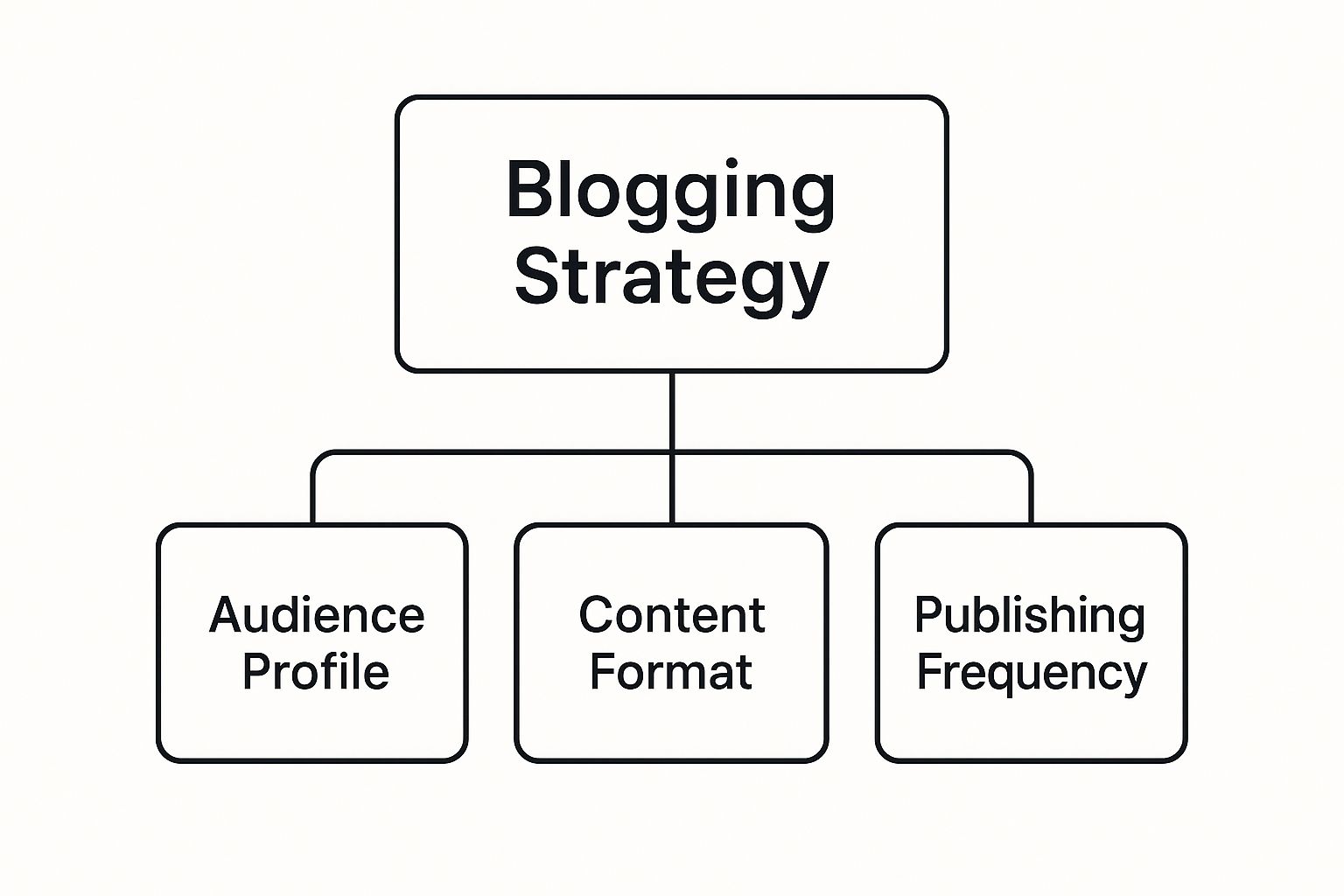When you're running a small business, it's easy to see blogging as just another item on an endless to-do list. But it's so much more than just writing articles. Think of it as your hardest-working employee—a digital expert who’s on the clock 24/7, attracting new customers and building trust while you focus on running your business.
Why Blogging Is Your Small Business Growth Engine

Let's be real: as a small business owner, your time is precious. The thought of adding "write a blog post" to your week can feel daunting. But what if you shifted your perspective? A blog isn't just another task; it's a powerful marketing asset that becomes the engine for your entire online presence.
Imagine your website is a shop. Without a blog, it's a nice little store tucked away on a quiet side street, waiting for someone to happen upon it. With a blog, it’s like putting up a giant, flashing neon sign on the main highway, actively pulling in people who are already looking for the very things you sell.
Your 24/7 Digital Expert
Every time you publish a well-written blog post, you're essentially creating a new salesperson who works for you around the clock. It answers your customers' most common questions, demonstrates your expertise, and starts building a relationship with potential buyers long before they're ready to make a purchase.
This approach—educating and helping your audience—is the heart and soul of smart content marketing for small business owners. Each article is a new doorway to your website, giving people more chances to find you.
The numbers back this up. Businesses with a blog see 55% more website visitors and generate a whopping 67% more leads than those without one. Even better, it gives your search engine ranking a massive boost, leading to 434% more indexed pages on Google. That makes it a whole lot easier for customers to find you instead of your competition.
A blog familiarizes people with your business, humanizes your organization, and helps build the trust that is essential for converting prospects into loyal customers. It puts relationships before sales.
To put it simply, a business blog turns your website from a static brochure into a dynamic, lead-generating machine. Here’s a quick look at how these benefits translate into tangible business growth.
Key Benefits of Business Blogging at a Glance
| Benefit | Impact on Your Business |
|---|---|
| Increased Website Traffic | More potential customers discover your brand through search engines. |
| Enhanced SEO Performance | Ranks higher on Google for keywords your customers are searching for. |
| Lead Generation | Captures contact information from interested prospects. |
| Builds Authority & Trust | Establishes your business as a credible expert in your field. |
| Drives Long-Term Results | A single post can generate traffic and leads for years. |
| Supports Social Media | Provides a steady stream of valuable content to share with your followers. |
These advantages work together, creating a powerful cycle of growth where each new blog post strengthens your overall marketing efforts.
The Foundation of Your Marketing Efforts
Beyond just bringing people to your site, your blog becomes the central hub for all your other marketing activities. It’s the source of high-quality material that fuels your social media, email newsletters, and more, ensuring your message is always consistent and helpful.
Here’s how a blog underpins your entire strategy:
- Fuels Social Media: Stop wondering what to post. One great blog article can be sliced and diced into a dozen different social media updates, from interesting quotes to quick tips and direct links.
- Powers Email Newsletters: Your best-performing blog posts are perfect for your newsletters. They give your subscribers something genuinely useful to read and encourage them to click back to your site.
- Builds Authority and Trust: When you consistently publish insightful content that solves your audience's problems, you naturally become their go-to resource. People buy from businesses they know and trust, and a blog is one of the most effective ways to earn it.
Building Your Strategic Blogging Blueprint
Great blogs don't just happen. They're built on a solid plan. Before you even think about writing your first sentence, you need a blueprint—a strategy that ensures every article you publish is actually working for your business. This isn't about getting bogged down in marketing theory; it's about taking a few simple, practical steps to give your content purpose.
It all starts with knowing exactly who you're talking to. Picture your ideal customer. I mean, really picture them. What are their biggest headaches? What problems keep them up at night? Sketching out this simple customer persona is the single most important thing you'll do. Everything else flows from here.
The infographic below really nails this idea, showing how your audience, content format, and publishing schedule all stack up.

See how understanding your audience is the foundation? Get that right, and decisions about what to write and when to post become so much clearer. Without it, you're just guessing.
Define Your Core Content Pillars
Once you have a clear picture of your audience, it's time to map out your core content pillars. Think of these as the three to five main topics that live at the sweet spot where your customers' needs meet your expertise. These pillars are like the main support beams for your blog—they keep everything you write relevant and focused on your business goals.
Let's say you run a local accounting firm. Your pillars might look something like this:
- Small Business Tax Tips: This directly tackles a huge source of stress for your ideal clients.
- Bookkeeping Best Practices: Here, you're offering practical, valuable advice that builds trust and showcases your expertise.
- Growth & Profitability Strategies: This positions you as more than just a number-cruncher; you're a strategic partner in their success.
Each pillar is broad enough to spark tons of article ideas but specific enough to keep you on track. This simple framework stops you from wandering off-topic and ensures your blogging for small businesses efforts are always pulling in the same direction.
A content strategy isn't about creating content for everyone. It's about creating the right content for the right people—the ones who will eventually become your customers.
With your pillars in place, brainstorming becomes easy. Just think about the questions your customers ask you every single day. Every one of those questions is a potential blog post waiting to attract more people just like them.
Choose Your Content Formats
Content isn't one-size-fits-all. Different formats achieve different things, and it’s smart to focus on what works for your audience and, just as importantly, what you can realistically produce on a consistent basis. How-to articles are wildly popular, making up a massive 72% of published blogs for a reason: they deliver immediate, practical value. Still, with two-thirds of marketers admitting they're not sure where to best put their resources, it pays to be strategic. You can discover more insights about which formats deliver the best return on your time and effort.
Here are a few proven formats to consider:
- How-To Guides: Step-by-step walkthroughs that solve a very specific problem.
- Listicles: Scannable and shareable articles like "5 Ways to…" or "10 Mistakes to Avoid."
- Case Studies: Real-world stories showing how you helped a customer get great results.
- Checklists: Handy, often downloadable, resources that your readers can use right away.
Create a Simple Editorial Calendar
Finally, an editorial calendar is what turns your blueprint into a real, actionable plan. This doesn't have to be some complex project management tool; a simple spreadsheet is perfect. The whole point is to plan ahead so that blogging becomes a proactive part of your marketing, not a last-minute scramble.
Your calendar just needs to track the basics:
- Publish Date: This keeps you on a consistent schedule.
- Blog Post Title: A working headline for the piece.
- Content Pillar: To make sure you're covering all your core topics.
- Status: A simple tracker (e.g., Idea, Drafting, Published) to see where everything stands.
This simple tool is what brings your strategy to life, turning great ideas into a steady stream of valuable content that will attract, engage, and ultimately win you new customers.
Creating Content That Attracts and Converts

Alright, you've got your blueprint. Now it's time to actually start building. This is where your strategy gets its hands dirty and becomes a real, tangible asset for your business—one that can turn casual readers into devoted customers.
Think of every blog post as a conversation that guides your reader. Your headline is the friendly wave that gets their attention, the intro is the firm handshake, and the body of the article is the chat that builds trust. And the destination? A clear, simple next step that helps them and helps you.
Anatomy of a High-Performing Blog Post
The best blog posts aren't just thrown together; they share a common structure designed to grab attention and make information incredibly easy to absorb. Getting this right is crucial for any small business blog because it ensures your hard-earned wisdom actually gets read.
Your main job is to remove any and all friction. Let's be honest, people scan online. A massive wall of text is like a "Do Not Enter" sign. We need to create posts that are easy on the eyes and a breeze to navigate.
Here’s the basic DNA of a post that works:
- A Magnetic Headline: This is your one shot to earn a click. It has to promise a real solution or spark some serious curiosity.
- An Engaging Introduction: The first couple of sentences need to hook the reader, reassure them they’re in the right place, and make them eager to scroll down.
- A Well-Structured Body: This is where short paragraphs, clear subheadings, bullet points, and images become your best friends. They break up the text and guide the reader’s journey.
- A Compelling Call-to-Action (CTA): The grand finale. This is where you explicitly tell the reader what to do next. Don't leave them hanging!
This structure shows respect for your reader's time while nudging them toward your business goals. For a deeper dive, our guide on how to create engaging content is packed with more advanced techniques.
Frameworks for Popular Content Types
You don’t have to reinvent the wheel every time you sit down to write. Proven content frameworks are your shortcut to producing quality articles, fast. Each one is built to solve a specific reader need, which is how you start building that all-important trust.
Let's break down two of the most powerful formats for small businesses.
The "How-To" Guide
This is the absolute workhorse of business blogging. It solves a specific problem for your audience, immediately positioning you as a helpful expert.
- Start with the Problem: State the pain point you’re solving, loud and clear.
- Break Down the Solution: Use a numbered list or distinct subheadings for each step.
- Provide Actionable Details: Give real examples, screenshots, or photos to make it foolproof.
- Conclude with the Outcome: End by reminding them of the awesome result they'll get from following your advice.
The Case Study
A great case study is a sales pitch wrapped in a compelling story. It offers powerful social proof by showing potential customers what it’s really like to work with you.
- Introduce the Client: Give a quick sketch of the customer and their situation.
- Detail the Challenge: Explain the specific problem they were wrestling with before you came along.
- Outline Your Solution: Describe the service or product you provided and how you put it into action.
- Showcase the Results: This is where you bring in the numbers. Use hard data like “increased revenue by 35%” or “saved 10 hours per week” to prove the transformation. A quote from the client is the cherry on top.
To get a handle on the bigger picture, you can explore the principles of effective content creation for small business that apply to any format you choose.
The Art of the Call-to-Action
A blog post without a Call-to-Action (CTA) is like a fantastic conversation that just… ends. It’s a huge missed opportunity. Every single article you publish needs to guide the reader toward a specific, valuable next step.
Your CTA is the bridge between your content and your business objectives. It's the mechanism that converts a reader's interest into a tangible lead or sale.
A CTA doesn’t always have to be a hard sell like "Buy Now." The right one depends entirely on where the reader is in their journey with you.
- Top of Funnel (Awareness): They're just realizing they have a problem.
- Good CTA: "Download our free checklist to learn more."
- Middle of Funnel (Consideration): They're actively looking at different solutions.
- Good CTA: "Watch a demo of our software in action."
- Bottom of Funnel (Decision): They're ready to pull the trigger.
- Good CTA: "Schedule a free consultation today."
By matching your CTA to your content's purpose, you create a smooth, helpful path that turns curious readers into happy customers and your blog into a reliable engine for growth.
Making Your Blog Easy for Google (and People) to Find
Writing a fantastic blog post is a great start, but it's only half the job. The other half? Making sure people can actually find it. That's where Search Engine Optimization (SEO) comes in. It might sound like a super technical, complicated thing, but for a small business blog, it really just boils down to a few core practices that can make a huge difference in your visibility.
Think of it this way: SEO is like giving Google a crystal-clear, easy-to-read map to your content. When someone searches for a solution you offer, you want your blog post to be one of the top destinations Google points them to. Get this right, and your blog transforms from a simple collection of articles into a powerful magnet for new customers.
Finding the Right Keywords
Keywords are simply the words and phrases your ideal customers are typing into Google. The real trick is to get inside their heads and focus on what they're actually looking for, not just the industry jargon you might use.
A local baker might assume "gourmet cupcakes" is the golden ticket, but their customers are probably searching for things like "best birthday cupcakes near me." It's a subtle but critical shift in perspective.
You don't need a massive budget or fancy software to start digging. A few free tools can give you some amazing insights:
- Google Trends: See what's popular and find related search terms people are using.
- AnswerThePublic: This is a goldmine for finding hundreds of real questions people are asking about your topic.
- Google's "People also ask" section: Right on the search results page, Google shows you the immediate follow-up questions people have. Use them!
By targeting these longer, more specific phrases (known as long-tail keywords), you’re not just getting traffic—you're getting traffic from people with a very specific problem or need, making them far more likely to be interested in your solution.
Weaving Keywords into Your Content Naturally
Once you've picked your target keyword, the goal is to use it in a way that feels completely natural. Don't just cram it into every other sentence. Your writing should always, always sound human first. This is a foundational principle for anyone learning how to optimize blog posts for SEO in a way that actually works.
Focus on placing your main keyword in these key spots:
- The Post Title (H1 Tag): This is your big headline and the most important place for your keyword.
- The First Paragraph: Mention it early on to signal to both readers and Google what the article is about.
- Subheadings (H2 & H3 Tags): Sprinkling keywords into your subheadings helps structure the content and reinforces the topic.
- Image Alt Text: This is the text that describes an image for search engines and visually impaired users. It's a simple, often-missed spot to include a keyword.
SEO isn’t about tricking Google. It’s about helping Google understand your content so it can connect you with the right audience. Your number one priority should always be creating a genuinely helpful resource for the person on the other side of the screen.
Simple On-Page SEO Tactics That Pack a Punch
Beyond just keywords, a few other simple habits can give your rankings a nice little boost. Think of these as the finishing touches that tell search engines your content is well-organized and high-quality.
Internal Linking
This is just a fancy way of saying you should link from one of your blog posts to another relevant post on your own website. For instance, if you write an article on "5 Ways to Save Time on Bookkeeping," it's a perfect opportunity to link to your other post about "Choosing the Right Accounting Software." This keeps people on your site longer and helps Google discover all the great content you've created.
Image Optimization
Huge image files can make your website load at a snail's pace, and that's a big no-no for SEO. Before you upload any picture, run it through a free online compression tool. Also, give the file a descriptive name. Instead of "IMG_1234.jpg," name it something like "small-business-tax-tips.jpg."
At the end of the day, creating great content is still the king of SEO. A recent study found that 72% of marketers believe content creation is their most effective SEO tactic. And with 80% of bloggers now using AI in their workflows—especially for brainstorming—it's clear that the tools are evolving. You can discover more about these blogging trends to see how the landscape is shifting. By mastering these SEO basics, you’re making sure all the hard work you put into your writing gets the audience it deserves.
Spreading the Word: How to Promote Your Content and Expand Your Reach

That feeling of hitting “publish” on a new blog post is fantastic, but your work isn’t over. In fact, the most important part is just getting started. A brilliant article that nobody sees isn't going to win you any customers or build your brand. This is where promotion comes in.
Think about it like this: if you created an amazing new product, you wouldn't just leave it sitting on a shelf in the back room and hope people stumble upon it. You’d put it in the front window, talk it up, and make sure everyone knows it exists. The exact same logic applies to your content.
Start With Your Warmest Audience
The best place to begin promoting your content is with the people who already know and trust you. I'm talking about your email subscribers and social media followers. These folks have already raised their hands and said, "Yes, I want to hear from you!"
Craft a quick email to your list announcing the new post. But don't just drop a link and call it a day. Give them a reason to click by explaining why it's valuable to them. A catchy subject line and a short, intriguing summary will work wonders for your open and click-through rates.
At the same time, share the article across your social media channels. Again, go beyond just posting the title and a link. Pull out a surprising statistic, a powerful quote, or a key insight from the article. Create a teaser that genuinely makes people curious to learn more.
Get More Mileage by Repurposing Your Content
As a small business owner, your time is gold. That's why content repurposing is your secret weapon. It’s all about taking one big piece of content—like your blog post—and slicing it into many smaller, bite-sized pieces for different platforms. This lets you maximize your reach with minimal extra work.
This strategy isn't about being repetitive; it's about being resourceful. You’re simply presenting the same core message in fresh formats to catch different segments of your audience where they hang out.
Repurposing allows you to reinforce your expertise and stay top-of-mind by presenting the same valuable information in fresh, engaging formats.
Here’s how one blog post can fuel a whole week's worth of content:
- Quote Graphics: Turn key takeaways into shareable images for Instagram or Facebook.
- Short Video Script: Use the main points to film a quick TikTok or YouTube Shorts video.
- Infographic: Summarize data or a how-to guide into an infographic for Pinterest.
- LinkedIn Post: Share the professional insights from your article to start a conversation with your network.
- Twitter Thread: Break down the core argument of your post into a series of punchy tweets.
Tap into Relevant Online Communities
Guess what? Your ideal customers are already gathered in online communities, talking about the very problems your blog post solves. Finding and engaging with these groups is a powerful way to drive high-quality traffic back to your site.
Look for active Facebook groups, LinkedIn groups, relevant subreddits, or industry-specific forums. The key here is to lead with value. Don't just show up, drop a link, and vanish. That’s spammy. Instead, become part of the conversation. Answer questions, offer advice, and build a reputation as a helpful expert.
When the moment is right—like when someone asks a question your article perfectly answers—you can share your post as a helpful resource. This approach builds credibility and feels authentic, not promotional. For more great ideas, check out these social media marketing tips for small businesses.
By combining these strategies, you ensure all the hard work you put into blogging for small businesses actually gets seen and makes a real impact.
Measuring Your Blogging Success and Improving Performance
You've put in the hard work and created some fantastic content. Now for the big question: is it actually doing anything? Measuring your blog's performance isn't about getting tangled up in spreadsheets. It’s about listening to what your audience is telling you through their clicks and actions so you can give them more of what they love.
Think of your blog's data as direct feedback. It shows you exactly what people find interesting, what solves their problems, and what keeps them coming back. By zeroing in on a few key numbers, you can turn that data into a clear roadmap for what to write next, ensuring your efforts lead to real business growth.
Key Metrics Every Small Business Should Track
You don’t need to be a data scientist to understand your blog's health. With a free tool like Google Analytics, you can get a powerful snapshot of what's working by keeping an eye on just a handful of metrics.
These numbers answer the most important questions about your content:
- Pageviews: Which articles are getting the most attention? A post with high pageviews is a billboard telling you what topics your audience craves.
- Average Engagement Time: How long are people sticking around to read? A high number here means your content is genuinely helpful and engaging, not just a quick click.
- New Users: Are you bringing new people into your world? This shows if your blog is successfully reaching beyond your existing customer base.
- Conversions: This is the money metric. Are people signing up for your newsletter, downloading your guide, or filling out a contact form after reading a post? This ties your blog directly to business results.
Tracking performance isn’t just about looking back at what you’ve done. It’s about getting clear directions on where to go next. Your data is the most honest feedback you'll ever get.
Essential Blogging Metrics and What They Mean
To make sense of the data, it helps to know what each metric is really telling you. Here’s a quick guide to the most important numbers for a small business blog and the simple question each one answers.
| Metric | What It Tells You | Tool to Use |
|---|---|---|
| Pageviews | "Which of my posts are the most popular?" | Google Analytics |
| Average Engagement Time | "Is my content actually interesting and valuable?" | Google Analytics |
| New Users | "Is my blog attracting new people to my business?" | Google Analytics |
| Bounce Rate | "Are people leaving immediately after landing on a page?" | Google Analytics |
| Keyword Rankings | "Where do my posts appear in Google search results?" | Google Search Console, Ahrefs |
| Conversions | "Is my blog directly helping me generate leads or sales?" | Google Analytics |
Looking at these metrics together gives you a complete picture. High pageviews are great, but if they come with a high bounce rate, it might mean your title is good but your content isn't delivering. That's the kind of insight that helps you improve.
Turning Insights into Actionable Improvements
Once you start checking these numbers, you'll begin to spot patterns. The real magic happens when you use those patterns to make smarter decisions. You're no longer guessing what your audience wants—you know.
For instance, if you see that your "how-to" guides consistently have the highest engagement time, that’s a loud and clear signal to create more of them. If an article about a niche service is bringing in a steady stream of new users from Google, maybe it's time to expand that topic into a detailed series.
It's also crucial to have realistic expectations for traffic. Benchmarks vary wildly by industry; B2B companies see a median of around 3,840 monthly sessions, while B2C businesses might pull in closer to 9,190 sessions. What this tells us is that steady, targeted traffic is often more valuable than a huge, unqualified audience. You can explore more blogging statistics on Databox.com to see how you stack up.
A Simple Framework for Continuous Improvement
Don't let analytics become a chore. You don't need to live inside your dashboard. A simple monthly check-in is all it takes to spot trends and make smart adjustments.
Here's a straightforward process to get into the habit:
- Review Top-Performing Posts: At the end of the month, pull up your top five posts by pageviews and engagement time.
- Identify the Common Threads: What do they have in common? Are they all listicles? Do they all tackle a specific customer pain point? Are they a certain length?
- Analyze Underperforming Content: Now, find a few posts that are collecting dust. Could the headline be more compelling? Is the topic too broad? Maybe it needs a better call to action.
- Plan Your Next Month's Content: Use what you just learned to brainstorm topics and formats that have a proven track record with your audience.
This simple loop turns data into a predictable engine for growth, ensuring every article you publish is more strategic than the last.
Got Questions About Business Blogging? We've Got Answers.
Jumping into the world of blogging for your business can feel a little daunting. It's completely normal to have a few questions swirling around before you start. Let's tackle some of the most common ones so you can get started with confidence.
How Much Time Does This Really Take?
Let's be honest: time is the most precious resource for any small business owner. The numbers show that the average blog post takes about 3 hours and 51 minutes to write. That can sound like a huge chunk of your day.
But here's a different way to look at it. Think of that time as an investment, not just an expense. A single, well-written article can attract new customers for years to come, long after you've hit "publish." It's no wonder that a staggering 91% of B2B companies rely on content like blogs to grow their brand. You can find even more compelling blogging statistics on MasterBlogging.
A single blog post can attract customers for years, delivering a return far greater than the initial hours spent creating it.
What Should I Even Write About?
This is probably the most common fear, but the good news is, you're sitting on a goldmine of ideas. The best topics come directly from the people you talk to every day: your customers.
Think about it. What are they constantly asking you?
- What are the big problems they're trying to solve with your product or service?
- What questions always pop up during a sales call or initial consultation?
- What are the common myths or misconceptions about your industry that you find yourself correcting?
Every one of those questions is a fantastic starting point for a blog post. Jot down the top ten questions you get asked. Boom—you've just outlined your first ten articles.
How Often Do I Need to Post?
Consistency trumps frequency, every single time. It's much more effective to publish one incredibly helpful, high-quality article every other week than it is to churn out three rushed, mediocre posts in the same timeframe.
Find a rhythm that works for you. Maybe that's one or two solid posts a month to start. Once you get into the swing of things and start seeing traffic come in, you can always decide to post more often. The goal is to build a sustainable routine you can maintain for the long haul.
Ready to turn your blog into a predictable source of traffic, leads, and sales? Copy Masters delivers 30 expertly crafted, search-optimized articles every month to help you dominate your market. Get your risk-free SEO content at https://copymasters.co.
- SaaS SEO Consulting for Predictable Growth - October 20, 2025
- What Is SEO Management Your Guide to Real Results - October 19, 2025
- A Guide to Quality Content for SEO That Ranks - October 18, 2025
